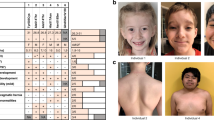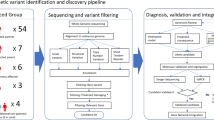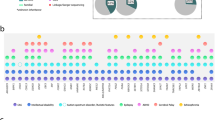Key Points
-
Familial disorders of speech and language provided early evidence that genetic mutations could impair these abilities, but a causative mutation in a single gene was only recently identified. Mutations in FOXP2 cause an inherited verbal dyspraxia associated with an orofacial movement disorder in a family known by the label KE.
-
Although the behavioural phenotype has been carefully studied, it is still unclear whether all the effects of the mutation are caused by a single core deficit in orofacial movement, or whether there are additional core deficits that can account for the grammatical, semantic and cognitive impairments that are found in affected family members.
-
MRI scans of affected individuals showed no obvious focal abnormalities on conventional neuroradiological assesments, but more detailed analyses have revealed reductions in the volumes of several brain areas that are involved in motor functions, including the caudate nuclei, Broca's area, the precentral gyrus and the ventral cerebellum. Functional neuroimaging studies have also shown some abnormalities in patterns of activation.
-
FOXP2 encodes a transcription factor that is expressed in the brain, lungs, heart and gut. In the brain, it is widely expressed in sensory, limbic and motor structures.
-
The effects of a mutation in FOXP2, together with data on its expression, allow us to propose a model of FOXP2-dependent circuitry. We assume that the circuitry that underlies normal speech is similar to the frontostriatal and frontocerebellar circuits that modulate and control the motor cortex in the performance of other types of movement. Most of the areas in the proposed circuit express FOXP2, and several of these show abnormalities in affected members of the KE family.
-
Much work is needed to clarify the details of the deficits caused by mutations in FOXP2 and to provide evidence that supports or contradicts our proposed circuitry. This work will involve behavioural, imaging, gene expression and gene knockout studies.
Abstract
That speech and language are innate capacities of the human brain has long been widely accepted, but only recently has an entry point into the genetic basis of these remarkable faculties been found. The discovery of a mutation in FOXP2 in a family with a speech and language disorder has enabled neuroscientists to trace the neural expression of this gene during embryological development, track the effects of this gene mutation on brain structure and function, and so begin to decipher that part of our neural inheritance that culminates in articulate speech.
This is a preview of subscription content, access via your institution
Access options
Subscribe to this journal
Receive 12 print issues and online access
$189.00 per year
only $15.75 per issue
Buy this article
- Purchase on Springer Link
- Instant access to full article PDF
Prices may be subject to local taxes which are calculated during checkout




Similar content being viewed by others
References
Lai, C. S. L., Fisher, S. E., Hurst, J. A., Vargha-Khadem, F. & Monaco, A. P. A forkhead-domain gene is mutated in a severe speech and language disorder. Nature 413, 519–523 (2001). Reports the identification of FOXP2 , a forkhead-domain gene, which is mutated in the affected members of the KE family and disrupted by a translocation breakpoint in an unrelated case C.S. who has the same phenotype of verbal and orofacial dyspraxia as the affected KE members.
Hurst, J., Baraitser, M., Auger, E., Graham, F. & Norell, S. An extended family with a dominantly inherited speech disorder. Dev. Med. Child Neurol. 32, 347–355 (1990).
Gopnik, M. Genetic basis of grammar defect. Nature 347, 26 (1990).
Fletcher, P. Speech and language defects. Nature 346, 226 (1990).
Vargha-Khadem, F. & Passingham, R. Speech and language defects. Nature 346, 226 (1990).
Vargha-Khadem, F., Watkins, K., Alcock, K., Fletcher, P. & Passingham, R. Cognitive and praxic deficits in a large family with a genetically transmitted speech and language disorder. Proc. Natl Acad. Sci. 92, 930–933 (1995).
Vargha-Khadem, F. et al. Neural basis of an inherited speech and language disorder. Proc. Natl Acad. Sci. 95, 12695–12700 (1998).
Belton, E., Gadian, D. G. & Vargha-Khadem, F. Evidence for specific motor programming deficit in developmental verbal dyspraxia but not in SLI. Soc. Neurosci. Abstr. 196.20 (2003).
Gathercole, S. E. & Baddeley, A. D. Evaluation of the role of phonological STM in the development of vocabulary in children: a longitudinal study. J. Mem. Lang. 28, 200–213 (1989).
Alcock, K. J., Passingham, R. E., Watkins, K. E. & Vargha-Khadem, F. Oral dyspraxia in inherited speech and language impairment and acquired dysphasia. Brain Lang. 75, 17–33 (2000).
Fisher, S. E., Vargha-Khadem, F., Watkins, K. E., Monaco, A. P. & Pembrey, M. E. Localisation of a gene implicated in a severe speech and language disorder. Nature Genet. 18, 168–170 (1998).
Watkins, K. E., Dronkers, N. & Vargha-Khadem, F. Behavioural analysis of an inherited speech and language disorder: comparison with acquired aphasia. Brain 125, 452–464 (2002). The most recent and comprehensive description of the neuropsychological profile of the affected members of the KE family in relation to a group of patients with adult-onset aphasia resulting from left hemisphere stroke. The study describes similarities and differences in performance between the aphasic patients and the affected family members.
Belton, E., Gadian, D. G. & Vargha-Khadem, F. The KE family: a severe motoric deficit selective to speech. Soc. Neurosci. Abstr. 595.8 (2004).
Watkins, K. E. et al. MRI analysis of an inherited speech and language disorder: structural brain abnormalities. Brain 125, 465–478 (2002).
Belton, E., Salmond, C. H., Watkins, K. E., Vargha-Khadem, F. & Gadian, D. G. Bilateral brain abnormalities associated with dominantly inherited verbal and orofacial dyspraxia. Hum. Brain Mapp. 18, 194–200 (2003). The most recent voxel-based morphometric analysis of MRI datasets using a conjunction analysis that compares grey matter densities bilaterally in affected members with those in unaffected members and matched controls. Results showed that the affected members have bilateral reductions of grey matter in a number of regions, including the caudate nucleus, cerebellum and inferior frontal gyrus.
Salmond, C. H. et al. Detecting bilateral abnormalities with voxel based morphometry. Hum. Brain Mapp. 11, 223–232 (2000).
Liegeois, F. et al. Language fMRI abnormalities associated with FOXP2 gene mutation. Nature Neurosci. 6, 1230–1237 (2003). Shows functional brain abnormalities associated with the FOXP2 mutation during fMRI language experiments involving covert and overt verb generation and word repetition. The report confirms that language areas are functionally abnormal in the affected KE family members, showing a more posterior and more extensively bilateral distribution pattern than in the unaffected members.
Carlsson, P. & Mahlapuu, M. Forkhead transcription factors: key players in development and metabolism. Dev. Biol. 250, 1–23 (2002).
Shu, W., Yang, H., Zhang, L., Lu, M. M. & Morrisey, E. E. Characterization of a new subfamily of winged-helix/forkhead (Fox) genes that are expressed in the lung and act as transcriptional repressors. J. Biol. Chem. 276, 27488–27497 (2001).
Li, S., Weidenfeld, J. & Morrisey, E. E. Transcriptional and DNA binding activity of the Foxp1/2/4 family is modulated by heterotypic and homotypic protein interactions. Mol. Cell. Biol. 24, 809–822 (2004).
Lai, C. S. L., Gerrelli, D., Monaco, A. P., Fisher, S. E. & Copp, A. J. FOXP2 expression during brain development coincides with adult sites of pathology in a severe speech and language disorder. Brain 126, 2455–2462 (2003). Reports the spatial and temporal expression pattern of FOXP2 mRNA in the developing brains of mice and humans. The pattern implicates FOXP2 in the development of corticostriatal and olivocerebellar circuits involved in motor control.
Ferland, R. J., Cherry, T. J., Preware, P. O., Morrisey, E. E. & Walsh, C. A. Characterization of Foxp2 and Foxp1 mRNA and protein in the developing and mature brain. J. Comp. Neurol. 460, 266–279 (2003).
Takahashi, K., Liu, F. C., Hirokawa, K. & Takahashi, H. Expression of Foxp2, a gene involved in speech and language, in the developing and adult striatum. J. Neurosci. Res. 73, 61–72 (2003).
Teramitsu, I., Kudo, L. C., London, S. E., Geschwind D. H. & White, S. A. Parallel FoxP1 and FoxP2 expression in songbird and human brain predicts functional interaction. J. Neurosci. 24, 3152–3163 (2004). Gene expression patterns of FoxP1 and FoxP2 in the songbird reveal a 'corticostriatal' song-circuit pattern that is congruent with brain abnormalities in the affected KE family members.
Haesler, S. et al. FoxP2 expression in avian vocal learners and non-learners. J. Neurosci. 24, 3164–3175 (2004).
Lu, M. M., Li, S., Yang, H. & Morrisey, E. E. Foxp4: a novel member of the Foxp subfamily of winged-helix genes co-expressed with Foxp1 and Foxp2 in pulmonary and gut tissues. Mech. Dev. 119 (Suppl. 1), S197–S202 (2002).
Wang, B., Lin, D., Li, C. & Tucker, P. Multiple domains define the expression and regulatory properties of Foxp1 forkhead transcriptional repressors. J. Biol. Chem. 278, 24259–24268 (2003).
Alexander, G. E., DeLong, M. R. & Strick, P. L. Parallel organization of functionally segregated circuits linking basal ganglia and cortex. Annu. Rev. Neurosci. 9, 357–381 (1986).
Middleton, F. A. & Strick, P. L. Basal ganglia and cerebellar loops: motor and cognitive circuits. Brain Res. Rev. 31, 236–250 (2000).
Kelley, R. M. & Strick, P. L. Cerebellar loops with motor cortex and prefrontal cortex of a nonhuman primate. J. Neurosci. 23, 8432–8444 (2003).
Lecours, A. R. The 'pure form' of the phonetic disintegration syndrome (pure anarthria); anatomo-clinical report of a historical case. Brain Lang. 3, 88–113 (1976).
Tonkonogy, J. & Goodglass, H. Language function, foot of the third frontal gyrus, and rolandic operculum. Arch. Neurol. 38, 486–490 (1981).
Tanji, K. et al. Pure anarthria with predominantly sequencing errors in phoneme articulation: a case report. Cortex 37, 671–678 (2001).
Tanji, K., Suzuki, K., Endo, K., Fujii, T. & Yamadori, A. Caudal ventral premotor area and articulatory programming. Soc. Neurosci. Abstr. 288.286 (2003).
Hillis, A. E. et al. Re-examining the brain regions crucial for orchestrating speech articulation. Brain 127, 1479–1487 (2004).
Ziegler, W., Kilian, B. & Deger, K. The role of the left mesial frontal cortex in fluent speech: evidence from a case of left supplementary motor area hemorrhage. Neuropsychologia 35, 1197–1208 (1997).
Tanji, J. & Shima, K. Role for supplementary motor area cells in planning several movements ahead. Nature 371, 413–416 (1994).
Hikosaka, O. et al. Parallel neural networks for learning sequential procedures. Trends Neurosci. 22, 464–471 (1999).
Tanji, J. Sequential organization of multiple movements: involvement of cortical motor areas. Annu. Rev. Neurosci. 24, 631–651 (2001).
Lai, C. S. L. et al. The SPCH1 region of human 7q31: genomic characterization of the critical interval and localization of translocations associated with speech and language disorder. Am. J. Hum. Genet. 67, 357–368 (2000).
Saleem, R. A., Banerjee-Basu, S., Berry, F. B., Baxevanis, A. D. & Walter, M. A. Structural and functional analyses of disease-causing missense mutations in the forkhead domain of FOXC1. Hum. Mol. Genet. 12, 2993–3005 (2003).
Enard, W. et al. Molecular evolution of FOXP2, a gene involved in speech and language. Nature 418, 869–872 (2002). An investigation of changes in FOXP2 across many species. The analysis indicates that the gene evolved into its present form in humans about 200,000 years ago, about the time that anatomically modern humans emerged.
Zhang, J., Webb, D. M. & Podlaha, O. Accelerated protein evolution and origins of human-specific features: Foxp2 as an example. Genetics 162, 1825–1835 (2002).
Acknowledgements
We are grateful to P. Strick and K. Tanji for valuable advice regarding many of the functional neuroanatomical issues raised in this article.
Author information
Authors and Affiliations
Corresponding author
Ethics declarations
Competing interests
The authors declare no competing financial interests.
Related links
Related links
DATABASES
Entrez Gene
OMIM
FURTHER INFORMATION
Glossary
- VERBAL DYSPRAXIA
-
An impaired ability to perform the coordinated movements that are required for speech.
- DYSPHASIA
-
Impairment of speech and verbal comprehension.
- OROFACIAL PRAXIS OR ORAL PRAXIS
-
Oral praxis is the volitional control of skilled non-speech movements.
- BROCA'S APHASIA
-
Severe impairment of verbal expression by speech or writing due to pathology of the left inferior frontal convolution, named after the French surgeon who discovered the relationship.
- DERIVATIONAL AND INFLECTIONAL MORPHOLOGY
-
The part of grammar that deals with the formation of one word from another by the addition of a prefix or suffix, often to change the case, gender, number or tense.
- T1-WEIGHTED MRI
-
MRI scans can be acquired with various types of contrast. T1-weighted images are weighted according to the so-called spin-lattice relaxation time (T1) of the protons that give rise to the MRI signals; such images provide good contrast between grey and white matter.
- LOD SCORE
-
A mathematical function that provides a measure of the strength of linkage between genetic loci in a breeding study. A lod score of 3 or more is considered to provide initial evidence that linkage exists.
- BACTERIAL ARTIFICIAL CHROMOSOME
-
(BAC). A vector containing an origin of replication that enables genomic or other DNA fragments, inserted into the vector, to be grown in bacteria.
- FORKHEAD GENES
-
A family of evolutionarily related genes, the FOX genes. FOX proteins regulate the transcription of target genes by binding their regulatory DNA sequences. This binding is performed by a special protein structure, the winged helix, which is encoded by the forkhead DNA sequence in the FOX gene.
- LEUCINE ZIPPER
-
A structural feature of some proteins in which two alpha helical regions, one from each protein monomer, are held together by hydrophobic interactions between leucine residues. The leucine zipper allows protein dimerization (pairing), which is necessary for the DNA-binding activity of some transcription factors.
- PATCH COMPARTMENTS
-
These are distinguishable histochemically from the surrounding 'matrix' compartments of the neostriatum, the patches being rich in opiate receptors and substance P, and the matrix containing cholinergic neurons and a rich plexus of somatostatin-immunoreactive fibres.
Rights and permissions
About this article
Cite this article
Vargha-Khadem, F., Gadian, D., Copp, A. et al. FOXP2 and the neuroanatomy of speech and language. Nat Rev Neurosci 6, 131–138 (2005). https://doi.org/10.1038/nrn1605
Issue Date:
DOI: https://doi.org/10.1038/nrn1605
This article is cited by
-
FOXO family isoforms
Cell Death & Disease (2023)
-
Functional dissection of two amino acid substitutions unique to the human FOXP2 protein
Scientific Reports (2023)
-
The gradual coevolution of syntactic combinatorics and categorization under the effects of human self-domestication: a proposal
Cognitive Processing (2023)
-
Therapeutic modulation of JAK-STAT, mTOR, and PPAR-γ signaling in neurological dysfunctions
Journal of Molecular Medicine (2023)
-
The importance of deep speech phenotyping for neurodevelopmental and genetic disorders: a conceptual review
Journal of Neurodevelopmental Disorders (2022)



